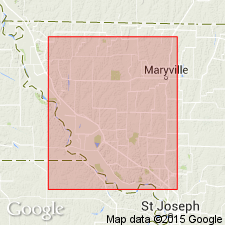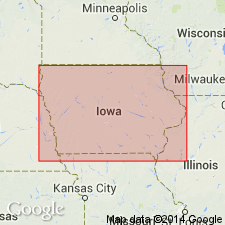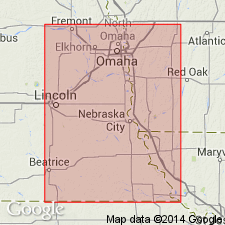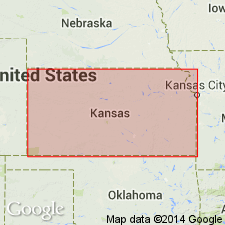
- Usage in publication:
-
- Forbes limestone
- Modifications:
-
- Overview
Summary:
Pg. 56. Mentioned Forbes limestone, but did not define it.
Source: US geologic names lexicon (USGS Bull. 896, p. 749).

- Usage in publication:
-
- Forbes limestone
- Modifications:
-
- Original reference
- Dominant lithology:
-
- Limestone
- AAPG geologic province:
-
- Forest City basin
Summary:
Pg. 349. Forbes limestone. Thick limestone, top exposed in top of bluffs of Missouri and Nodaway Rivers, near town of Forbes, Holt County, northwestern Missouri, being highest heavy limestone in Missourian series until capping Cottonwood limestone is reached.
Source: US geologic names lexicon (USGS Bull. 896, p. 749).

- Usage in publication:
-
- Forbes limestone
- Modifications:
-
- Overview
Summary:
In Missouri the name Forbes limestone was for many years applied to the beds beneath Calhoun shale and above Tecumseh shale, or to Deer Creek limestone member of present nomenclature.
Source: US geologic names lexicon (USGS Bull. 896, p. 749).

- Usage in publication:
-
- Forbes limestone
- Modifications:
-
- Not used
Summary:
Pg. 49. The upper unit of Deer Creek limestone has been called Forbes limestone in Missouri, Iowa, and Nebraska. Writer is of opinion this name should be retained for this unit, but the USGS holds that it would be preferable to select some other name. Replaced with Ervine Creek limestone.
Source: US geologic names lexicon (USGS Bull. 896, p. 749); GNC KS-NE Pennsylvanian Corr. Chart, sheet 1, Oct. 1936.

- Usage in publication:
-
- Forbes limestone†
- Modifications:
-
- Abandoned
- AAPG geologic province:
-
- Forest City basin
Summary:
Pg. 181. †Forbes limestone of Gallaher, is poorly defined designation of limestone at Forbes, Holt County, northwestern Missouri, recognizable from description = Deer Creek.
Source: US geologic names lexicon (USGS Bull. 896, p. 749); GNC KS-NE Pennsylvanian Corr. Chart, sheet 2, Oct. 1936.
For more information, please contact Nancy Stamm, Geologic Names Committee Secretary.
Asterisk (*) indicates published by U.S. Geological Survey authors.
"No current usage" (†) implies that a name has been abandoned or has fallen into disuse. Former usage and, if known, replacement name given in parentheses ( ).
Slash (/) indicates name conflicts with nomenclatural guidelines (CSN, 1933; ACSN, 1961, 1970; NACSN, 1983, 2005, 2021). May be explained within brackets ([ ]).

